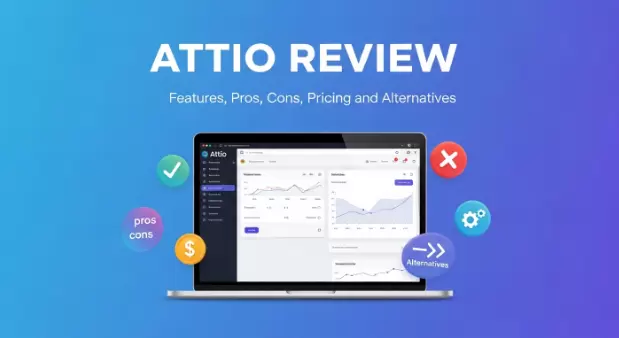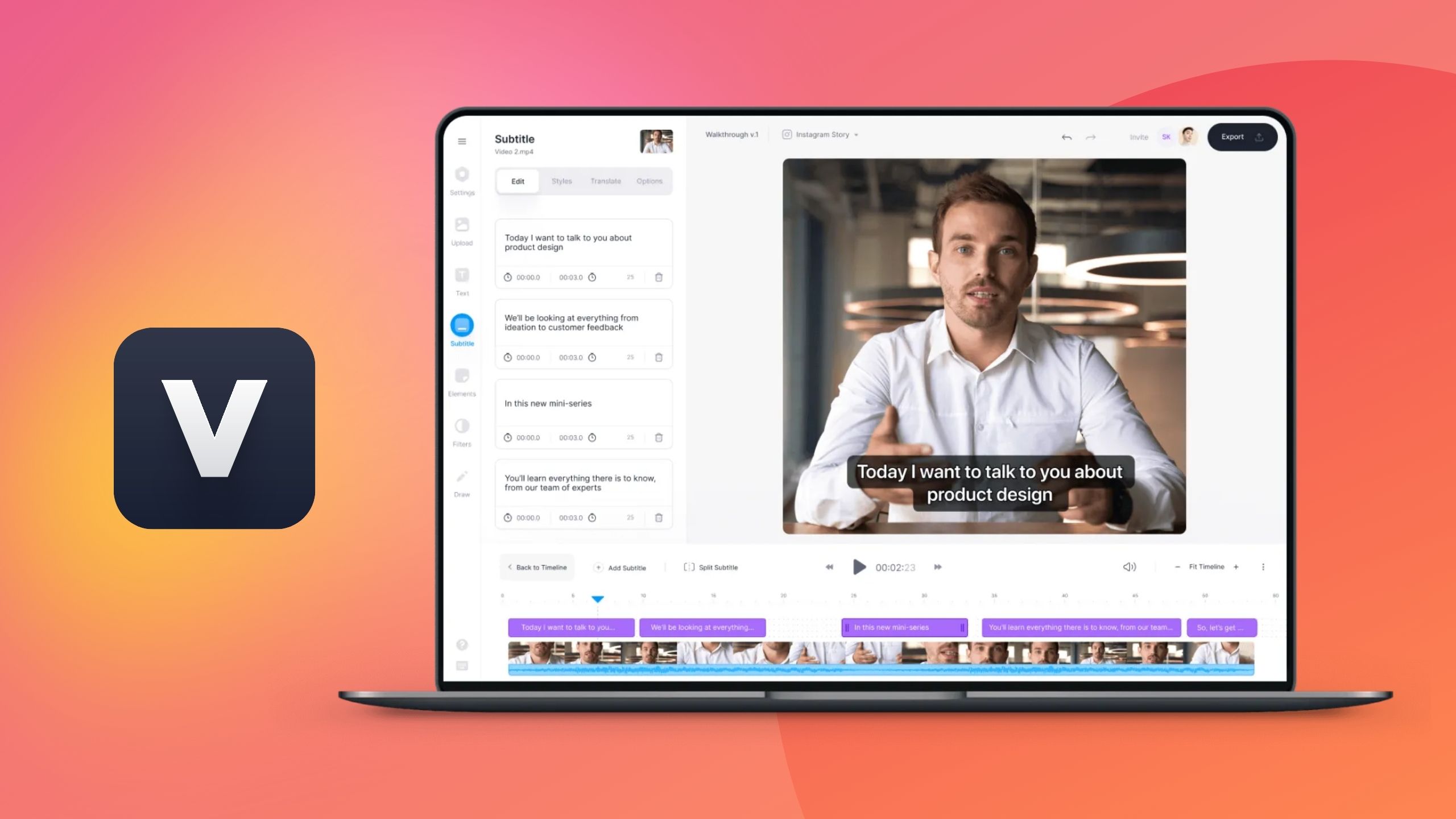Being multilingual in modern world is extremely important. For a developing business accessing new markets, a researcher with international collaborators, or someone simply traveling the world, everything needs to be translated quickly and accurately. This is where AI translation tools step in, providing cutting-edge solutions for stubborn language barriers.
With the quick growth of artificial intelligence, a new generation of translation tools has emerged from simple word-for-word translation. Solutions like Multilingual PDFs for publishers leverage AI-powered platforms that understand context, idiomatic expressions, and even industry-specific terminology, making translations sound more natural and accurate than ever before.
A complete review of some of the Best AI translation tools available today is provided in this comprehensive guide. We go deep into their unique features, strengths, and possible applications so you may find the best solution to your needs. From well-renowned names to innovative newcomers, we have covered the broad spectrum serving many needs-be it real-time conversation translation, document localization, or adaptation of multimedia content.
We'll be discussing in this panel session the broader implications of such tools in global communication, business, and cultural exchange. We will see how these advanced capabilities of translation break down language barriers, create international collaboration, and open up new opportunities for people and organizations alike.
Join us for an informative journey about the world of Artificial Intelligence(AI) translation tools and find out just how they will change the way we communicate across languages and cultures. Whether language enthusiasts, professional translators, or people looking to extend their influence globally, this is a guide that will provide insight into state-of-the-art technologies shaping the future of translation.
Let's now proceed to consider some of the best available AI translation tools, each with its unique features and abilities in helping one break through barriers with ease and precision.
1. QuillBot Translate (quillbot.com/translate)
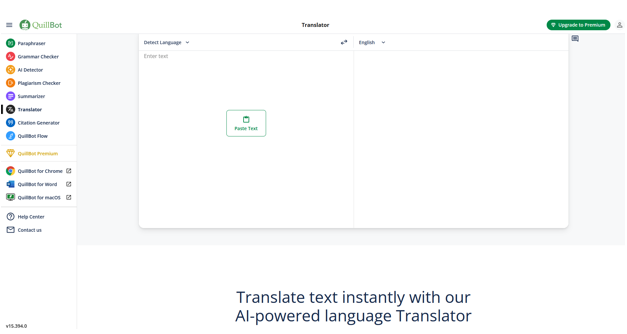
QuillBot is well-acknowledged for its AI-based paraphrasing tool; however, it also comes up with a strong translation feature. This translator comes in several languages and works incredibly for the translation of phrases and short texts. Its user-friendly interface and accurate translations draw students and professionals to it.
Key Features:
- Integrates with QuillBot's other language tools
- Offers paraphrasing options alongside translation
- Provides context-aware translations
- User-friendly interface with additional writing enhancement features
- Supports multiple translation modes (formal, simple, creative)
- Offers a Chrome extension for easy access
- Includes a plagiarism checker and citation generator
Pros:
- All-in-one platform for translation and writing improvement
- Unique paraphrasing feature for translated content
- Helpful for students and content creators
- Intuitive interface with real-time translations
Cons:
- Fewer language pairs compared to specialized translation tools
- May prioritize paraphrasing over direct translation in some cases
- Limited customization options for specialized terminology
2. Lokalise AI (lokalise.com/ai)
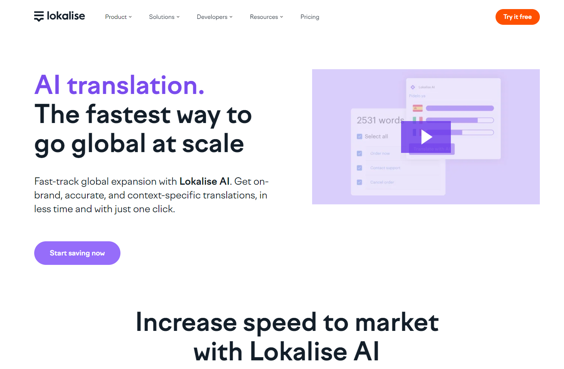
Lokalise is a platform for businesses those who are interested in translating digital products. It makes the whole localization process easier for companies through AI translation that has taken over the market, giving them faster access to different global markets. Lokalise provides teamwork involved in delivering the highest quality of translations.
Key Features:
- Seamless integration with development workflows
- Supports a wide range of file formats
- Offers machine learning-based quality assurance
- Provides collaboration tools for teams
- Includes translation memory and glossary management
- Offers visual context for translations (screenshots, video)
- Provides real-time statistics and analytics
Pros:
- Comprehensive solution for software localization
- Strong focus on collaboration and project management
- Excellent for maintaining consistency across large projects
- Integrates well with popular development tools and platforms
Cons:
- Steeper learning curve compared to simple translation tools
- Pricing may be high for individual users or small teams
- Primary focus on software and digital content localization
3. Wordvice AI (wordvice.ai)
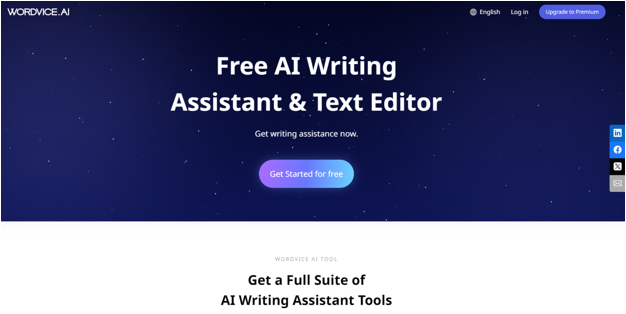
Wordvice is an AI-powered service specializing in translations of academic and professional documents. It produces high-quality, contextually accurate translations with the best words to fit whatever text is needed by the students, researchers, or professionals.
Key Features:
- Specializes in academic and professional content
- Offers human editing services alongside AI translation
- Provides field-specific terminology management
- Supports multiple document formats
- Includes plagiarism checking and formatting services
- Offers journal selection assistance for researchers
- Provides ESL (English as a Second Language) support
Pros:
- High-quality translations for specialized and technical content
- Combines AI efficiency with human expertise
- Comprehensive service for academic publishing needs
- Strong focus on maintaining academic integrity
Cons:
- More expensive than pure AI translation tools
- Longer turnaround times due to human editing component
- Primary focus on English as the target language
4. Smartcat (smartcat.com/machine-translation)
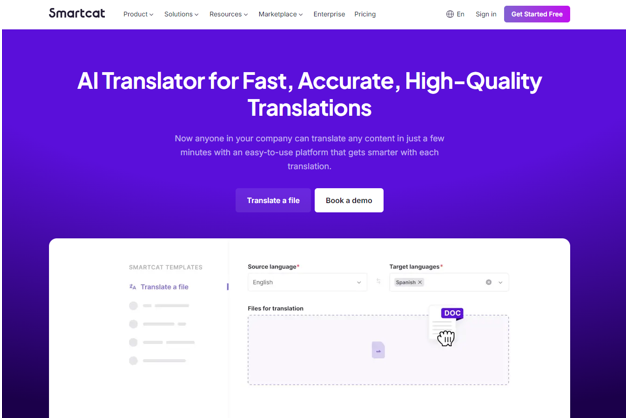
Smartcat is an all-in-one translation platform driven by AI for machine translations. Among its different tools for translators and businesses, it also hosts a marketplace where you can hire professional translators who can refine the AI-generated translations. Smartcat's AI-driven machine translation is fast and accurate, hence very useful for both freelancers and businesses.
Key Features:
- Integrates with a full suite of translation management tools
- Offers customizable machine translation engines
- Provides a collaborative platform for translation teams
- Supports a wide range of file formats and integrations
- Includes translation memory and terminology management
- Offers a marketplace for finding professional translators
- Provides real-time project progress tracking
Pros:
- Comprehensive platform for managing entire translation workflows
- Flexibility to use AI translation or human translators
- Strong focus on team collaboration and project management
- Pay-as-you-go pricing model
Cons:
- Can be complex for users needing simple translations
- Requires time investment to fully utilize all features
- AI translations may need human post-editing for best results
5. DeepL Translator (deepl.com/en/translator)
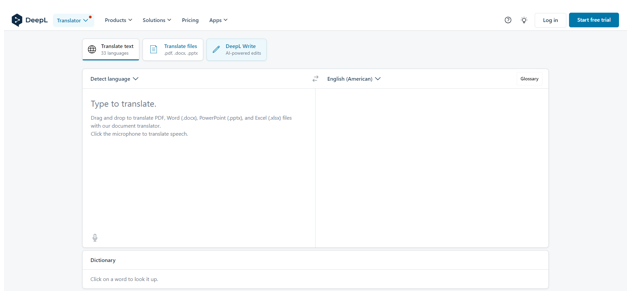
DeepL is one of the most impressive recent AI translation tools. It will indeed amaze you with its accuracy. DeepL translates using neural networks so that translations not only will be correct but also sound natural. DeepL supports a wide range of languages and is particularly popular among professionals who need quality translations.
Key Features:
- Supports over 30 languages
- Offers a user-friendly interface
- Provides a web app and API for developers
- Excels in translating longer texts and documents
- Offers a glossary feature for consistent terminology
- Provides real-time translation as you type
- Supports document translation with format preservation
Pros:
- Exceptional translation quality, often outperforming competitors
- Intuitive interface with clean design
- Fast processing speed, even for large documents
- Strong privacy focus with data deletion options
Cons:
- Limited language pairs compared to some competitors
- Free version has usage limitations
- No mobile app available (as of last update).
Also Read :7 Best AI Music Generator Tools of 2024
6. SYSTRAN (systransoft.com)
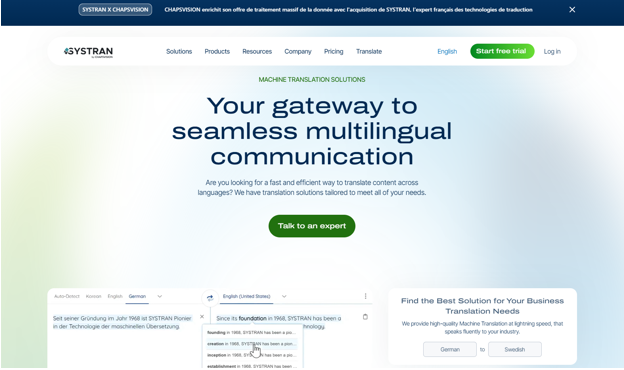
SYSTRAN is the most known name in the translation work, and its AI tools continue to capture the market. It creates tools for businesses with a need for reliable translations. The SYSTRAN platform supports more than 140 languages, while industry-specific translations are available for healthcare, finance, legal, and other sectors.
Key Features:
- Provides both generic and specialized translation engines
- Offers on-premise solutions for enhanced security
- Supports over 55 languages
- Provides APIs for easy integration into existing workflows
- Offers customizable neural machine translation models
- Includes terminology management and translation memory
- Provides real-time translation for instant messaging and email
Pros:
- Long-standing reputation in the translation industry
- Highly customizable for specific industry needs
- Strong focus on data security with on-premise options
- Scalable solutions from individual to enterprise level
Cons:
- Can be complex and costly for small-scale users
- Requires technical expertise for full customization
- User interface may not be as intuitive as some newer tools
7. Sonix AI (sonix.ai)

Sonix is an AI translation tool that helps turn audio and video files into different languages. It offers automated services of transcription and can also translate the same transcriptions into multiple languages. This is very helpful for content creators, journalists, and any businesses needing to translate multimedia content.
Key Features:
- Automated transcription and translation of audio and video files
- Supports over 40 languages
- Offers a user-friendly editor for fine-tuning translations
- Provides subtitle generation for videos
- Includes speaker identification and timecoding
- Offers a collaborative platform for team projects
- Provides API access for integration with other tools
Pros:
- High accuracy in transcription and translation of audio content
- Fast processing times, even for long audio files
- Intuitive interface for editing and exporting content
- Excellent for creating multilingual subtitles and captions
Cons:
- Primarily focused on audio/video content, not text translation
- May require human review for complex or technical content
- Pricing can be high for frequent or large-scale use
8. iTranslate (itranslate.com)
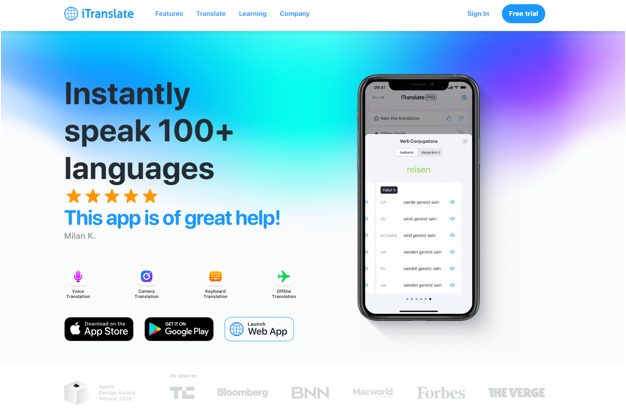
iTranslate is a mobile application that helps tourists and travelers since it is easy to use, works without the internet, and provides voice and text translations in over a hundred languages. iTranslate, driven by artificial intelligence, offers speed and precise translations, thus it is a must-have tool for everyone on the go.
Key Features:
- Offers text, voice, and camera translation
- Provides offline translation capabilities
- Includes a dictionary and phrasebook
- Supports over 100 languages
- Offers augmented reality translation for signs and menus
- Provides verb conjugations and language learning tools
- Includes a keyboard extension for in-app translations
Pros:
- User-friendly mobile app with intuitive interface
- Versatile with multiple translation modes
- Offline capabilities for travel use
- Helpful additional features for language learners
Cons:
- Translation quality may not match specialized tools for complex texts
- Some advanced features require a paid subscription
- Desktop version has more limited functionality compared to mobile
9. PROMT (promt.com)
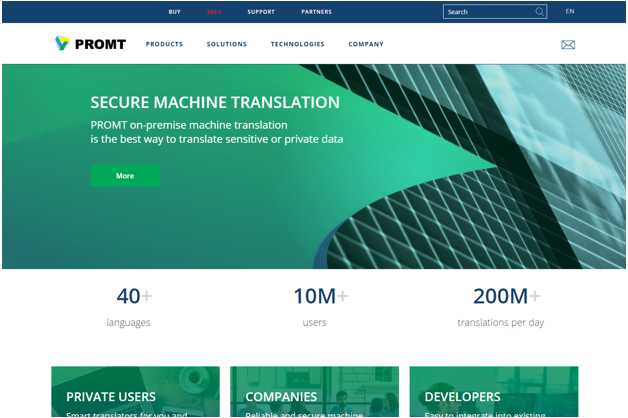
PROMT is yet another popular name in the translation industry. Businesses and individuals aiming for high accuracy in fast translationsPROMT could be the great option, which offers one of the most powerful AI-powered real time translation tools. In addition to healthcare and technology, PROMT specializes in many other fields and languages.
Key Features:
- Provides both online and offline translation options
- Offers specialized translation for various industries
- Supports document translation with formatting preservation
- Includes a dictionary and text-to-speech functionality
- Offers customizable translation engines for businesses
- Provides API access for integration with other systems
- Includes collaborative tools for team translation projects
Pros:
- High accuracy, especially for specialized and technical content
- Versatile with solutions for both individual and enterprise use
- Strong focus on data security and confidentiality
- Supports a wide range of document formats
Cons:
- User interface may feel less modern compared to newer tools
- Some features may require a learning curve
- Pricing for advanced features can be high for small-scale users
10. Papago (papago.naver.com)
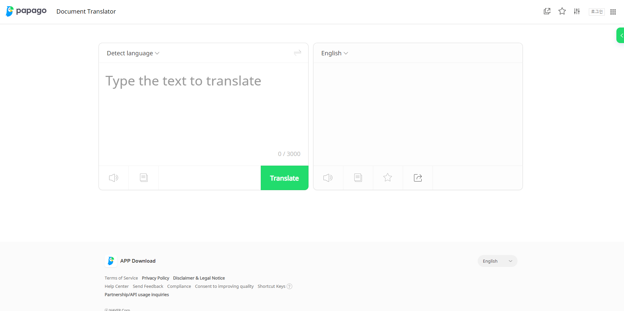
Papago is a regional, AI-powered translation tool developed by Naver. It is really popular across Asia and also supports a wide range of languages; it does text-to-text and voice translation. Its AI engine understands the context for more accurate translations of complex phrases and sentences.
Key Features:
- Specializes in Asian languages, particularly Korean
- Offers image and handwriting translation
- Provides a conversation mode for real-time translation
- Includes a dictionary and phrase book
- Offers website translation functionality
- Provides pronunciation guides and audio
- Includes a "name translator" for proper nouns
Pros:
- Exceptional accuracy for Asian languages, especially Korean
- User-friendly interface with unique features
- Free to use with no account required
- Helpful additional tools for language learners
Cons:
- Primary focus on Asian languages; may be less accurate for other language pairs
- Some features may be region-locked
- Limited customization options compared to enterprise-level tools
11. Wordly AI (wordly.ai)
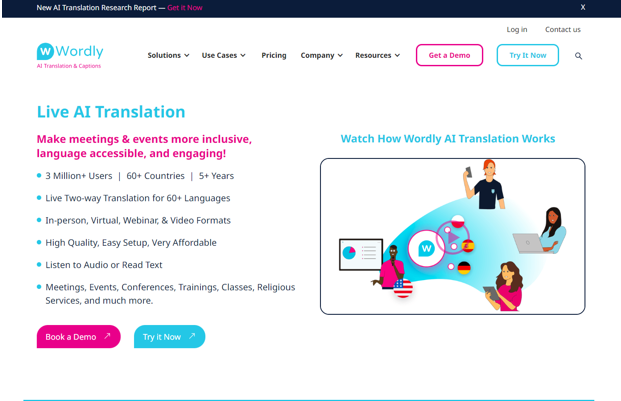
Wordly is an AI-driven translation tool for live events and meetings. Translations of multiple languages are done in real-time, making it rather easy for participants of different linguistic backgrounds to communicate effectively. The AI engine assures the right translations and those that are delivered in the least time. Therefore, this gadget will be worth it for businesses and organizations that organize international events.
Key Features:
- Offers real-time translation for live events
- Supports multiple languages simultaneously
- Provides both audio and text translations
- Integrates with various event platforms
- Offers customizable interfaces for different event types
- Provides analytics on language usage and engagement
- Supports both in-person and virtual events
Pros:
- Specialized solution for multilingual events and conferences
- Scalable to support large audiences in multiple languages
- Easy integration with existing event technologies
- Reduces the need for human interpreters in many scenarios
Cons:
- Primarily focused on live events, not suitable for general translation needs
- May require technical setup and testing before events
- Accuracy may vary depending on speakers and subject matter
12. Phrase AI (phrase.com/platform/ai)
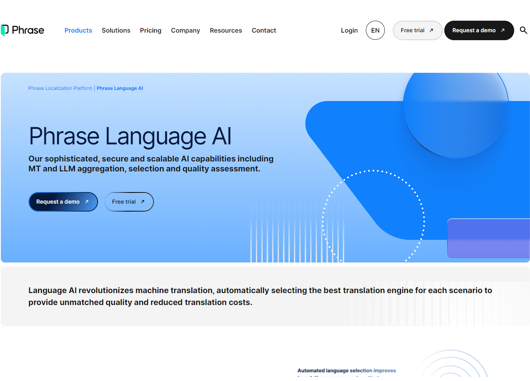
Phrase is an all-in-one localization platform powered by AI for faster translations. It will be ideal for businesses that would want to translate their websites, apps, and other digital content. Phrase offers a collaborative environment where teams can come together to ensure that translations are correct and relevant in context.
Key Features:
- Integrates AI translation into a comprehensive localization workflow
- Offers terminology management and translation memory
- Provides collaboration tools for localization teams
- Supports a wide range of file formats and integrations
- Includes quality assurance tools and style guides
- Offers version control and change tracking
- Provides analytics and reporting on localization projects
Pros:
- Comprehensive solution for managing entire localization projects
- Strong focus on consistency and quality across large-scale translations
- Excellent integration with development workflows
- Scalable for growing businesses and expanding language needs
Cons:
- May be overly complex for simple translation needs
- Requires time investment to set up and optimize workflows
- Pricing may be high for small businesses or individual users
Conclusion: Embracing the Future of Translation
In the detailed guide above, we have discussed how each of these AI translation tools has come quite a distance in recent years, offering unprecedented accuracy, speed, and versatility to help leap across the language barrier. From DeepL for its excellent translations to the multimedia translator Sonix AI, from Lokalise with its many developer-friendly features to innovative event interpretation provided by Wordly AI, the gamut runs for every kind of translation need that might arise.
The benefits of using such translation tools are not limited to just enhancing the ease of communication. They are landscape Changemakers, opening the door to developing new markets for business, fostering international teams and research, increasing people’s appreciation for each other and enhancing the diversity of the content to different people worldwide. If and when these fantastic technologies progress further, there should be even more mouth-watering technologies in the years to come which will eliminate subtitling and other forms of language instructions.
But let's not forget that while AI translation has come a long way, it is not without its limitations. For highly nuanced or critically important content, human oversight and editing continue to be of value. Many of the tools discussed herein recognize this, offering hybrid solutions which join the speed and efficiency of AI with nuanced understanding provided by human translators.
When evaluating the different alternatives for an AI translation tool, think about aspects such as the languages you work with, the type of content you're translating, how accurate you need them translated to be, and other requirements you might have or want. A lot of these tools offer free trials or basic versions, so don't be afraid to try out a few to find the one that best fits your workflow.
In summary, AI translation tools are changing how we communicate across languages, opening up new frontiers of global interaction and understanding. Whether a business leader, a content creator, a researcher, or just an enthusiast to break down the language barrier, these tools bring effective ways to connect with the world. Unlock the power of AI translation and move your global communication to the next level!
Remember: at least when it comes to languages and communication, the future is now – and it speaks any language. Happy translating!

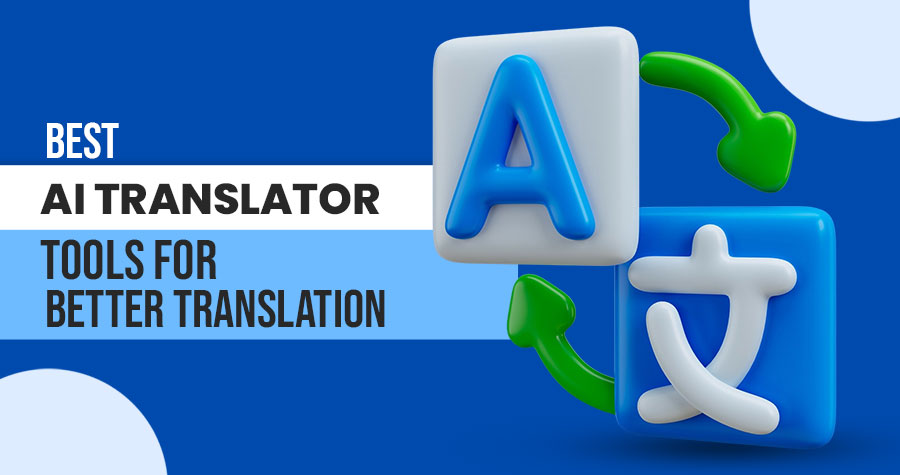
 Table of Content
Table of Content




